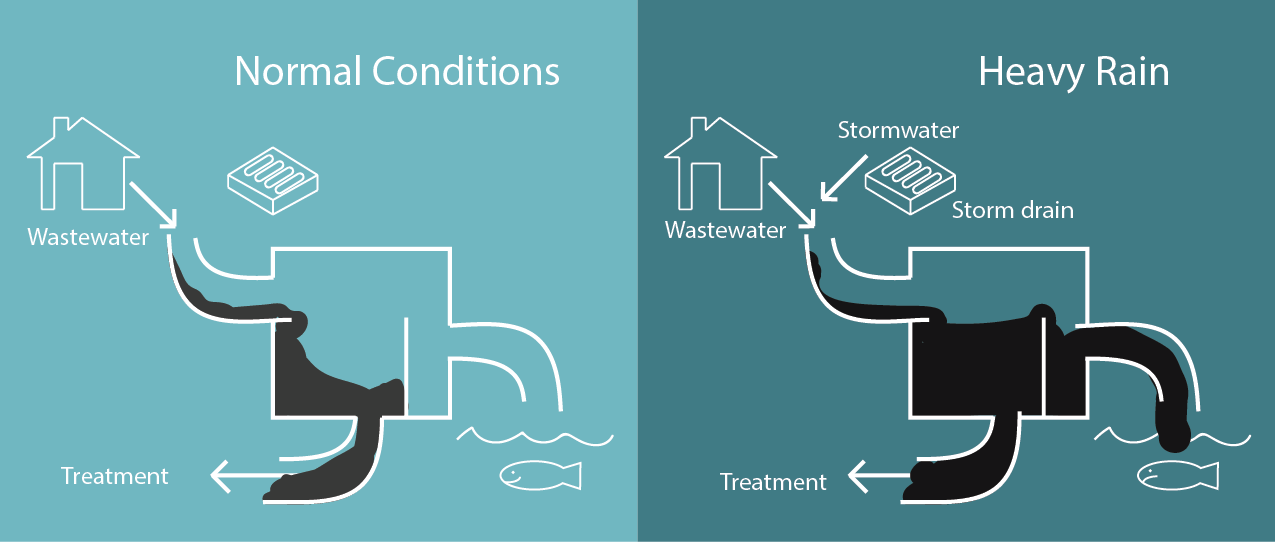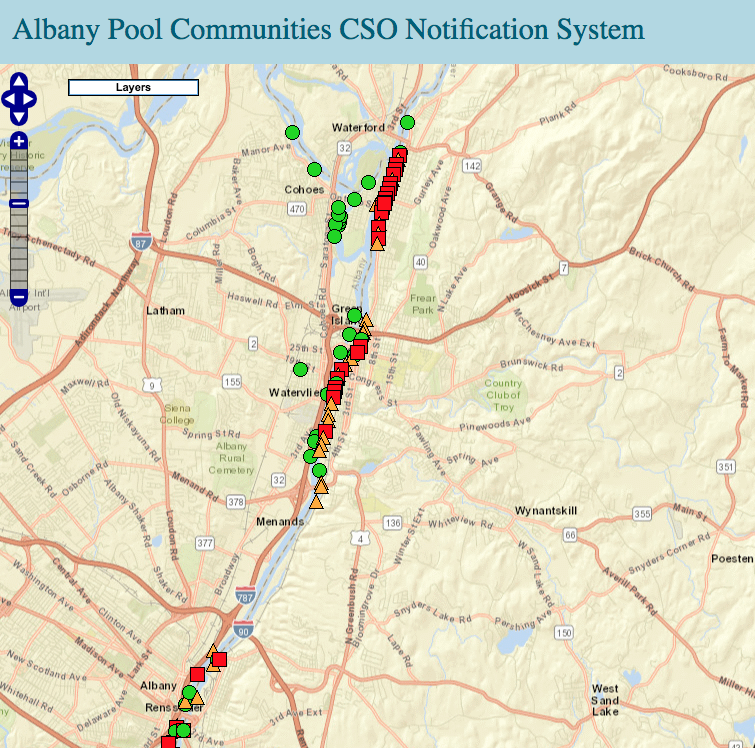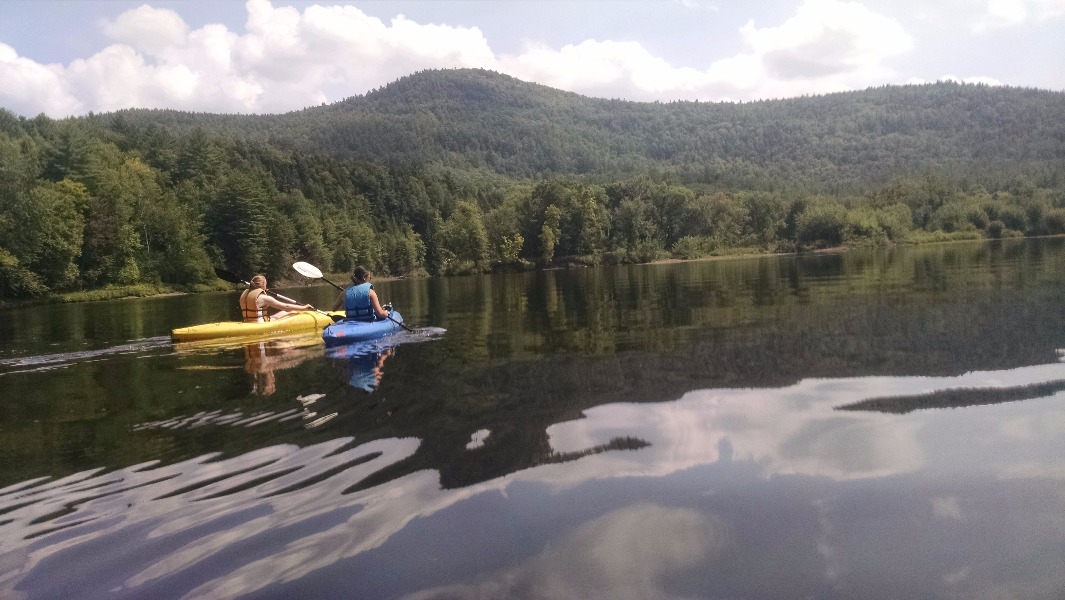
Research to Protect The Hudson
Donation protected
Do you know where everything goes when you flush it down the drain? It might surprise you that some of what flushes down your drain goes directly into the Hudson River. That’s right, there is raw sewage in the same river you fish from and boat in. Below is a video that shows the sewage in the Hudson River, next to residential and recreational areas. Condoms, tampon applicators, sanitary napkins, feces, corn!
So why does this happen? Here in the capital region in upstate New York, most of our cities and towns have what is called a combined sewer. This means that when it rains, the storm water and the water that goes down your drain goes to the same place. With such a large volume of water, there is an overflow. This overflow, called Combined Sewer Overflows, or CSOs, is piped directly into the Hudson River. The graphic below shows how a combined sewer works.
 CSOs have discharged incredibly large volumes of raw sewage into the Hudson River during heavy rain events for decades. There are 92 CSOs located in the Capitol District alone, their locations are shown below.
CSOs have discharged incredibly large volumes of raw sewage into the Hudson River during heavy rain events for decades. There are 92 CSOs located in the Capitol District alone, their locations are shown below.
 In 2011, the New York Department of Environmental Conservation published a Long Term Control Plan (LTCP) to mitigate the release of materials from the 92 CSOs within the Capital Region, or "Albany Pool". The plan only includes evaluation of fecal coliforms, E. Coli, termperature, pH, dissolved oxygen, total suspended solids, biological oxygen demand, phosphorous, ammonium, nitrate, and conductivity. These measures may have been appropriate 40 or 50 years ago, but they are completely inadequate. Present day overflows likely contain cocktails of chemicals, viruses, and antibiotic resistant microorganisms that present new hazards to water quality in the Hudson River.
In 2011, the New York Department of Environmental Conservation published a Long Term Control Plan (LTCP) to mitigate the release of materials from the 92 CSOs within the Capital Region, or "Albany Pool". The plan only includes evaluation of fecal coliforms, E. Coli, termperature, pH, dissolved oxygen, total suspended solids, biological oxygen demand, phosphorous, ammonium, nitrate, and conductivity. These measures may have been appropriate 40 or 50 years ago, but they are completely inadequate. Present day overflows likely contain cocktails of chemicals, viruses, and antibiotic resistant microorganisms that present new hazards to water quality in the Hudson River.
Sewage in the Hudson is a public health issue, not just an environmental one. This project seeks to identify some of the most hazardous components released from CSOs in the Capitol District with intentions for assessing possibilities for remediation. Ultimately, research described will contribute to improving water quality and making the Hudson cleaner, safer, and more beautiful. It would be really appreciated if you donated to my research! Together we can protect the river we all know and love.
Every donation, however small, helps!
To find out more about this project visit http://hudsonsewageremediation.blogspot.com/.
.
 A Little Bit About Me:
A Little Bit About Me:
My name is Amy Bredes and I am an undergraduate student at RPI studying environmental engineering. My father is an arborist through whom I gained a deep love for nature. Growing up on Long Island, playing in the water and loving the beach and the sand also greatly influenced me. These experiences and my ongoing fascination with water have guided me toward my field of study. Powered by love for the natural world, I am determined to do what I can to protect it from harm.
So why does this happen? Here in the capital region in upstate New York, most of our cities and towns have what is called a combined sewer. This means that when it rains, the storm water and the water that goes down your drain goes to the same place. With such a large volume of water, there is an overflow. This overflow, called Combined Sewer Overflows, or CSOs, is piped directly into the Hudson River. The graphic below shows how a combined sewer works.
 CSOs have discharged incredibly large volumes of raw sewage into the Hudson River during heavy rain events for decades. There are 92 CSOs located in the Capitol District alone, their locations are shown below.
CSOs have discharged incredibly large volumes of raw sewage into the Hudson River during heavy rain events for decades. There are 92 CSOs located in the Capitol District alone, their locations are shown below.  In 2011, the New York Department of Environmental Conservation published a Long Term Control Plan (LTCP) to mitigate the release of materials from the 92 CSOs within the Capital Region, or "Albany Pool". The plan only includes evaluation of fecal coliforms, E. Coli, termperature, pH, dissolved oxygen, total suspended solids, biological oxygen demand, phosphorous, ammonium, nitrate, and conductivity. These measures may have been appropriate 40 or 50 years ago, but they are completely inadequate. Present day overflows likely contain cocktails of chemicals, viruses, and antibiotic resistant microorganisms that present new hazards to water quality in the Hudson River.
In 2011, the New York Department of Environmental Conservation published a Long Term Control Plan (LTCP) to mitigate the release of materials from the 92 CSOs within the Capital Region, or "Albany Pool". The plan only includes evaluation of fecal coliforms, E. Coli, termperature, pH, dissolved oxygen, total suspended solids, biological oxygen demand, phosphorous, ammonium, nitrate, and conductivity. These measures may have been appropriate 40 or 50 years ago, but they are completely inadequate. Present day overflows likely contain cocktails of chemicals, viruses, and antibiotic resistant microorganisms that present new hazards to water quality in the Hudson River.Sewage in the Hudson is a public health issue, not just an environmental one. This project seeks to identify some of the most hazardous components released from CSOs in the Capitol District with intentions for assessing possibilities for remediation. Ultimately, research described will contribute to improving water quality and making the Hudson cleaner, safer, and more beautiful. It would be really appreciated if you donated to my research! Together we can protect the river we all know and love.
Every donation, however small, helps!
To find out more about this project visit http://hudsonsewageremediation.blogspot.com/.
.
 A Little Bit About Me:
A Little Bit About Me:My name is Amy Bredes and I am an undergraduate student at RPI studying environmental engineering. My father is an arborist through whom I gained a deep love for nature. Growing up on Long Island, playing in the water and loving the beach and the sand also greatly influenced me. These experiences and my ongoing fascination with water have guided me toward my field of study. Powered by love for the natural world, I am determined to do what I can to protect it from harm.
Organizer and beneficiary
Amy Leigh
Organizer
Troy, NY
Amy Bredes
Beneficiary